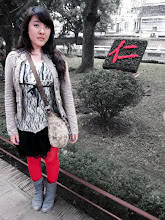Typhoon season in Taipei means the air’s thick with moisture. The heat feels corded through with something metallic, like the promise of thunder. Winnie and I got caught in the rain again, a light drizzling that dimmed our midday circuit through the Garden of Perfected Benevolence, a leaf-and-stone patch of bridges and waterfowl statuary by the Forbidden Palace Museum. By night in turned to flashflood, cut short our visit to the Shilin Night Market. We waited out the heaviest part at a throwaway noodle joint, watching through makeshift plastic windows the dark, furrowed brow of the sky god.
I’m not serious, by the way, when I talk about divinity in this tinselly way. Although I think there is something of the neo-pagan about the cheap vineyard scent of my words— a certain gauzy farce of the neo-pagan, anyway. As a sometimes agnostic, I worry a little about it, the way I use “God” as a rhetorical crutch. There’s something leering and fetishistic, maybe, about the way I seek out religious architecture and iconography. I remember writing to myself once this weird late-night reminder: “The way I comport myself with respect to Buddhism would be considered horrifically tacky if I were white.”
We passed a billboard on our way to the museum, at the Yuanshan station: “Tibetan Buddhism is not Buddhism. Lamas are not monks or nuns.” In Professor Quintman’s class on Biography in Asian Religion, we read this postcolonial history of Buddhology— the kind of thing that makes me instinctively roll my eyes, usually, before I start reading, a visceral distaste for characteristically contemporary discourses I admit to be unfair.
Anyway, Lopez claim that sort of thing was common in conventional western academic narratives about Buddhism. The Vajrayana was somehow adulterated, cordoned off from the pall of the sangha by a moniker of segregation, “Lamaism”. I felt this guilty weight of recognition, reading this poco with a discipline bigot’s uneducated grudge. My own instinct was to reject the Diamond Vehicle as doctrinally impure, perceiving what I thought of as its lavish silk-and-sex aesthetic as incompatible with Sakyamuni’s asceticism.
Intellectually, I knew I was full of it. And that needles at me, how I can spend all these terms studying Buddhism and still feel like I’ve learned so little, except a vague sense of unease about the samsara motel. It’s like how I can drool over cathedrals, but still nod with sanctimonious approval at the option for the poor. Just because they’re pretty.
There were a lot of gorgeous Buddhist relics in the museum, but because they didn’t let us take photos I’m not sure I saw any of it. Without the camera lens to give shape to my seeing, articulating it with framing and composition the way language articulates thought, I feel like my perception goes fuzzy. What I’m left with is a faint impression of beauty— a lot of little beauties that stay undifferentiated in my memory. Of course there’s more to experience than just memory-in-the-making; my failure to pick up a souvenir doesn’t mean I wasn’t there.
Sometimes with no photo a story suffices, to give shape to the raw stuff of my sensation. I remember the imperial dicta that dated from the Qing. They were written in Manchu script.
The Forbidden Palace Museum must be staffed by the best team of designers unrivalled this temporal side of Versailles. I was consistently impressed by the choice of typefaces. And that amused me a little, thinking about how hard Chinese letterers’ lives must be, how much freehanding has to go into the creation of every font. The degree of innovation and aesthetic dynamism that went into each display surprised me. At the Met, for example, the exhibits themselves are a blank canvas, foregrounding the collections themselves. At the Palace Museum, there’s a distracting artistry to every arrangement. Which is fine with me— I’m not interested enough in material culture to appreciate it on its own merits.
Afterwards we walked around the rare books and manuscripts library attached to the museum. They took our IDs like at the Beinecke, and at every reading table and microfilm station there were studious locals mired in what looked like legitimate research. It made me happy, this little academic tableau.
The Dao of Pandemic
5 years ago


No comments:
Post a Comment